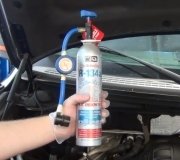Good morning, ONEDSOB,
True, pressures have stayed consistent. But that is with the compressor jumped and running.
Static pressures need to be taken after the engine is of for about 30 mins, the compressor should not be running. Then it needs to be compared to the chart.
That voltage signal is all over the place. Would you mind checking the static pressure with the vehicle off? I need the gauge readings without the compressor pressurizing the system.
You may not have a leak, but these readings will help diagnose the issue by giving us more information. Then we can compare with the readings you took with the compressor running.
How did the filter look?
That TSB I spoke about earlier, the HVAC module software update, does pertain to your vehicle so I would have the dealer update the software. Should only be charged for a half an hour to an hour labor. Then we can rule that out.
I also have found another TSB pertaining to the ambient temp sensor. On my 2001 Suburban it displays on my mirror. So your vehicle should have it there or on in the instrument cluster. I will add the TSB for you. It has a procedure to reset the ambient temp sensor. I would read it over and try it.
I have to send it in 2 images.
I am also adding the refrigerant capacities for you as well as the type of PAG oil and the amount.
If you added 4 12-ounce cans you are .5 lbs. over now on refrigerant.
You should have enough pressure but for some reason with the compressor on you still don't have 3v.
So, if you could:
1) Re-check static pressures with the engine off for about 30 minutes and no compressor on. Then compare it to the chart.
2) Take it to the dealer to have the software update the HVAC module. I would print a copy of the TSB for the software update and bring it with you to the dealer.
3) Using the TSB try resetting the ambient temp sensor as this will also make the compressor is not turned on.
I would then test this sensor, remove it and use your multimeter on the ohm setting. I am adding a video for you because it explains how to test it pretty clearly. Here is the link:
https://youtu.be/X7x_TwoRYRQ
I would also check the connector for corrosion or damage as well as the harness for any damage.
I have also added a diagram for the location of this sensor. Since it is at the front of the vehicle it's possible this sensor could be having an issue.
4) I would check all your fuses with a test light so we can make sure we aren't overlooking anything. Connect it to ground and touch both side of the fuse. If we have an electrical issue, I want to make sure all the fuses are good. Here is an informative article to show you how to do it in case you need it:
https://www.2carpros.com/articles/how-to-check-a-car-fuse
I will add the fuse panel diagram as well as the legend for each of them.
5) Since this voltage reading just will not reach 3.0v I am wondering if there is any extra resistance in the circuit as well. So, I would double check any harnesses and see if you can find anything.
I know it's frustrating, unfortunately all vehicles are lol, but out of all the people on here that I have talked to you have done the best in testing and communicating. I think you are doing great, and I don't blame you but hang in there. Plus, that is a nice truck be a shame to burn it lol.
Also, Thank you very much for the VIN and RPO codes. It will help a lot.
I know these tests are getting redundant, but that's kind of how diagnosis goes, sometimes double or triple checking is necessary but when it's fixed, the knowledge you gain and the feeling you fixed it will be well worth it in my opinion.
While you are doing that, I am going to take the day and go through the codes you sent me, RPO codes, wiring diagrams and any more TSB's I can find. Now that I have the VIN and RPO codes I can go over the entire diagnostic procedure with the information you have provided.
Thank you,
Brendon
Images (Click to make bigger)
Tuesday, May 9th, 2023 AT 6:55 AM



























































